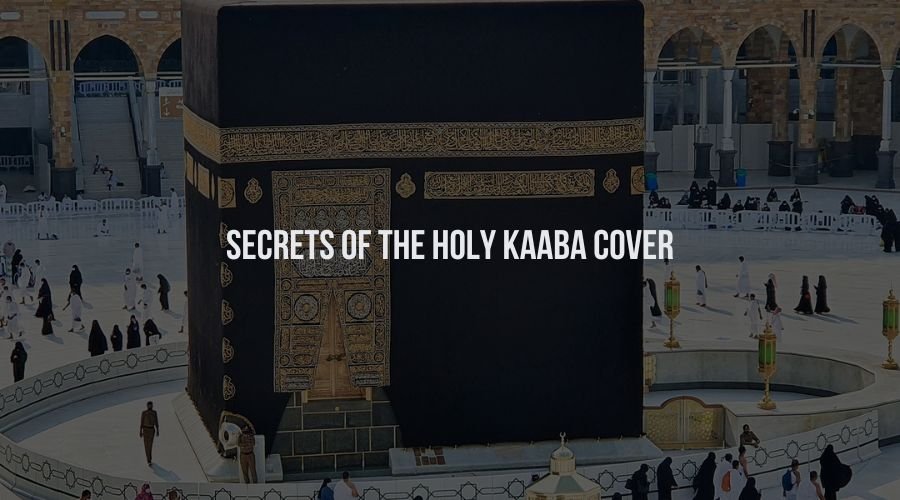I often worry about the curtain of Kaaba, or the House of Allah, whenever I perform the Umrah. How exquisite the calligraphy is! I could have stood there reading the ayats and admiring the Kaaba Kiswa for eternity. Which of the ayats are inscribed in it, I wondered? I started my investigation after thinking that this exquisite and complex design had some secrets. I was shocked to learn that the drape of Kaaba requires 20 million Saudi Riyals to make. Islam’s beauty lies in the fact that such a priceless item is given as a gift to Muslim nations and the entire people rather than being kept locked away. Praise be to Allah!
The cloth known as Kiswah is used to cover the Kaaba in Mecca, Saudi Arabia.Every year, on the 10th day of Dhu Al Hijjah, which falls on the same day as Haj, the sacred Kaaba is covered with new Kaaba Kiswa. Four thousand years before Islam’s founding, the Prophet Ismail (Pubh) initiated this habit. The Arabic word for “pall,” which is the cloth covering a coffin, is Kiswah.
The Cost Of Making Kaaba Cover
The current cost of manufacturing one Kaaba Cover is SAR 20,000,000. 670 kilograms of silk were used to make the 658 m2 cover. There are 15 kilograms of gold threads used in the needlework. Each of the 47 cloth pieces is 14 metres long and 101 centimetres broad. The Kaaba is encircled by the Kaaba Cover, which is fastened to its base with copper rings. The Kaaba is encircled by the kiswa, which is fastened to its base with copper rings. Computers are gradually helping with the hand-created Quranic verse embroidery, which will speed up manufacturing.
Dimensions of the Kaaba Kiswa
- It is fourteen metres high.
- The 45-metre-long and 95-centimetre-wide Kaaba Cover belt is located in the upper third of the fabric.
- It encircles the Kiswa cover from all sides and is made up of sixteen sections.
- The belt is embellished with embroidered motifs that protrude and are enamelled with gold-covered silver threads. The fabric is composed of silk, and a band of gold embroidery is sewed in about a quarter of the way from the bottom.
- Richly embroidered Quranic words cover a portion of the door, which is 2.13 metres above the ground on the northeast side wall, leaving an aperture for the black stone.
What is Written in the Kaaba Cover
CALLIGRAPHY: It is inscribed with Quranic verses in the Arabic calligraphic form known as the Ath-Thuluth.
1.Pure natural silk that has been dyed black makes up the Kiswa cover. The following words are etched on this silk:
“0′ Allah, Muhammad is Allah’s Messenger; there is no any other god. The Bene-factor, the Most Loving. Glory to Allah, blessings upon Allah, and praise to Allah the Almighty.
2. The Surah of Ikhlas (Purity of Faith) is inscribed beneath the belt at each corner of the Kaaba, inside a circle encircled by an Islamic decoration in the form of a square.
3. Six Holy Quranic verses are located at the same height, beneath the belt. These verses are composed in individual frames.
4. The words “O’ you the Alive the Self Subsisting” or “The Shape of a Lamp” are inscribed on the spaces that divide these frames. “Praise be to Allah,” or “The Most Gracious, the Most Merciful,” Everything inscribed beneath the belt of Kiswa cover is stitched in jutting designs, intertwined with silver threads coated in gold, and written in the Ath-Thuluth script style.
5. The Kaaba Kiswas were simple in the past. The tradition of the embroidered border was only introduced by Hassan, the Egyptian monarch, in 1340.
6. Kaaba Cover was not black: Throughout the reigns of several Caliphs and kings, the hue of Kaaba Cover changed. Prophet Mohammed’s (Pbuh) grandmother once offered white Kiswa. Three times a year, on the eighth of Dhu al-Hijjah, on the first of Rajab, and on the twenty-ninth of Ramadan, the Caliph Al-Ma’mun draped the Kaaba with a different color—red on that occasion, white gabati on that day, and red on that occasion. Subsequently, Al-Nasir covered the Kaaba in green draperies; however, he and Al-Ma’mun were at odds about the numerous colour changes, so he turned to black, which has been the only hue used for Kiswah ever since. Green Kaaba Kiswa was first introduced by Nassir Abbasi (1160–1207), who eventually switched to black Kaaba Kiswa, which has since remained the custom.
Making of Kaaba Cover
For eight months, approximately 200 men worked in a factory to make the Kiswah, a silk cover for the Kaaba that is black-dyed and embroidered with gold.
Today, 670 kg (1,500 lb) of premium silk imported from Italy and Switzerland make up the 658-square-metre covering.
To create the exquisite material, the silk is dyed black and spun in Saudi Arabia. 120 kg of pure gold and silver are then hand-embroidered onto it.
Distribution of Kaaba Kiswa
Every year, leading Muslim figures and Muslim nations receive fragments of the ancient Kaaba Kiswa as gifts.
Kaaba Kiswa is also cut and supplied to the general public.




